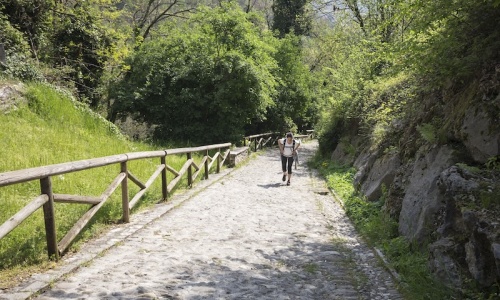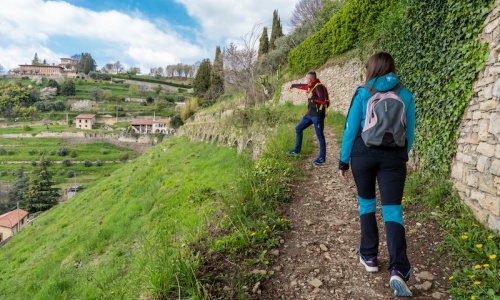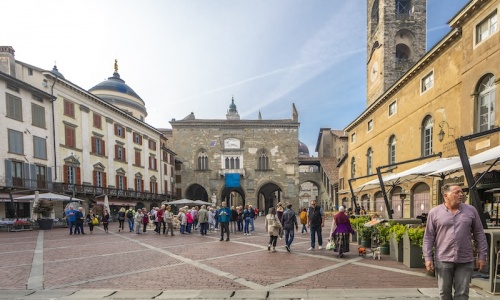Starting from the picturesque town of Ponteranica to the historic Upper City of Bergamo, you will discover a segment of the Nembro-Bergamo stage of the Via delle Sorelle, a 130-kilometer route that connects Brescia to Bergamo in both directions.

Reach Ponteranica by bus No. 7 or 9 and start from the Church of Saints Alexander and Vincent, located at Via Leone XIII, 13. The original structure dates back to the 15th century, with a neo-Gothic restoration that mainly characterizes the interior, featuring painted vaults and walls. The exterior retains its 15th-century style, except for the tall bell tower, which shows 19th-century interventions. Step inside the church and admire The Resurrection of Christ by the famous Venetian painter Lorenzo Lotto from 1522. After your visit, start descending Via IV Novembre, through the charming village streets, toward the pedestrian and cycling paths that cross the Parco dei Colli. The landscape is a living painting, where you may spot squirrels and observe the blooms of wood anemones and wild primroses.
Reach Ponteranica by bus No. 7 or 9 and start from the Church of Saints Alexander and Vincent, located at Via Leone XIII, 13. The original structure dates back to the 15th century, with a neo-Gothic restoration that mainly characterizes the interior, featuring painted vaults and walls. The exterior retains its 15th-century style, except for the tall bell tower, which shows 19th-century interventions. Step inside the church and admire The Resurrection of Christ by the famous Venetian painter Lorenzo Lotto from 1522. After your visit, start descending Via IV Novembre, through the charming village streets, toward the pedestrian and cycling paths that cross the Parco dei Colli. The landscape is a living painting, where you may spot squirrels and observe the blooms of wood anemones and wild primroses.

From Via IV Novembre, follow the blue and red signs of the route toward Bergamo. From here, you will walk along the Morla stream and turn left onto Via Faustina, eventually reaching Via Gianbattista Moroni. Continue until you cross Via Ramera, where you will carefully turn onto Strada al Mulino, which will lead you to the Greenway of the Morla and Quisa streams, also known as the Sombreno Cycle Path. This fully paved path is suitable for both adults and children, offering a beautiful backdrop of the walls of Upper Bergamo. The atmosphere becomes almost magical as you walk through the forest, with views of the former Valmarina monastery, a Benedictine institution from 1150, at the heart of the Parco Regionale dei Colli di Bergamo. At kilometer 3.7, take a right onto path 910, which features steep inclines. This section requires caution, as the next 200 meters have an uneven surface. After this challenging stretch, you’ll reach Via dei Roccoli, where you can enjoy a spectacular view of the plain below.
From Via IV Novembre, follow the blue and red signs of the route toward Bergamo. From here, you will walk along the Morla stream and turn left onto Via Faustina, eventually reaching Via Gianbattista Moroni. Continue until you cross Via Ramera, where you will carefully turn onto Strada al Mulino, which will lead you to the Greenway of the Morla and Quisa streams, also known as the Sombreno Cycle Path. This fully paved path is suitable for both adults and children, offering a beautiful backdrop of the walls of Upper Bergamo. The atmosphere becomes almost magical as you walk through the forest, with views of the former Valmarina monastery, a Benedictine institution from 1150, at the heart of the Parco Regionale dei Colli di Bergamo. At kilometer 3.7, take a right onto path 910, which features steep inclines. This section requires caution, as the next 200 meters have an uneven surface. After this challenging stretch, you’ll reach Via dei Roccoli, where you can enjoy a spectacular view of the plain below.

After walking another 600 meters, you will arrive at the Church of S. Sebastiano, also dedicated to St. Mary of Mercy. Inside, you can view frescoes dating back to the 14th and 15th centuries, and thanks to recent restoration, you can also see frescoes from the late 1300s. From here begins the Via del Rione stairway, an unprotected scenic path that will offer breathtaking views as you continue onto Via Alle Case Moroni, leading to Via San Sebastiano, and eventually reaching Via S. Vigilio.
After walking another 600 meters, you will arrive at the Church of S. Sebastiano, also dedicated to St. Mary of Mercy. Inside, you can view frescoes dating back to the 14th and 15th centuries, and thanks to recent restoration, you can also see frescoes from the late 1300s. From here begins the Via del Rione stairway, an unprotected scenic path that will offer breathtaking views as you continue onto Via Alle Case Moroni, leading to Via San Sebastiano, and eventually reaching Via S. Vigilio.

S. Vigilio is one of the most frequented spots by both locals and tourists due to its position overlooking Bergamo. It offers a panoramic view of the city and allows you to immerse yourself in the history of the area, with its small church, castle, and funicular, from which you can admire the towers and bell towers of the Upper City. At the end of Via S. Vigilio, turn left onto Largo Porta Sant’Alessandro, skirting the S. Vigilio funicular. Pass through Porta Sant’Alessandro, and you will reach Colle Aperto, a harmonious fusion of nature, history, and Bergamasque culture, surrounded by the ancient Venetian walls. Proceed to the right and pass through the archway leading to the historic heart of Upper Bergamo, the Visconti Citadel. Here you can visit the Civic Museum of Natural Sciences of Bergamo. Continue toward the tower you can see in the distance—it is the Campanella Tower, marking Piazza Mascheroni, the gateway to Via Colleoni, named after the famous 15th-century condottiero Bartolomeo Colleoni. Walking along this street is like reliving Bergamo’s past among the characteristic local shops. The walk eventually opens onto Piazza Vecchia, the "Renaissance parlor" of the city, where you can admire its perfectly proportioned architecture, centered around the Contarini Fountain from 1780, surrounded by stone lions and important historical buildings such as the Palazzo della Ragione, the Angelo Mai Civic Library, and an ancient solar sundial dating back to the 18th century. End your journey here, breathing in the atmosphere of Bergamo's platea magna nova.
S. Vigilio is one of the most frequented spots by both locals and tourists due to its position overlooking Bergamo. It offers a panoramic view of the city and allows you to immerse yourself in the history of the area, with its small church, castle, and funicular, from which you can admire the towers and bell towers of the Upper City. At the end of Via S. Vigilio, turn left onto Largo Porta Sant’Alessandro, skirting the S. Vigilio funicular. Pass through Porta Sant’Alessandro, and you will reach Colle Aperto, a harmonious fusion of nature, history, and Bergamasque culture, surrounded by the ancient Venetian walls. Proceed to the right and pass through the archway leading to the historic heart of Upper Bergamo, the Visconti Citadel. Here you can visit the Civic Museum of Natural Sciences of Bergamo. Continue toward the tower you can see in the distance—it is the Campanella Tower, marking Piazza Mascheroni, the gateway to Via Colleoni, named after the famous 15th-century condottiero Bartolomeo Colleoni. Walking along this street is like reliving Bergamo’s past among the characteristic local shops. The walk eventually opens onto Piazza Vecchia, the "Renaissance parlor" of the city, where you can admire its perfectly proportioned architecture, centered around the Contarini Fountain from 1780, surrounded by stone lions and important historical buildings such as the Palazzo della Ragione, the Angelo Mai Civic Library, and an ancient solar sundial dating back to the 18th century. End your journey here, breathing in the atmosphere of Bergamo's platea magna nova.